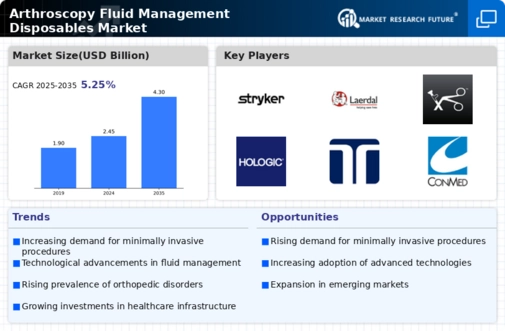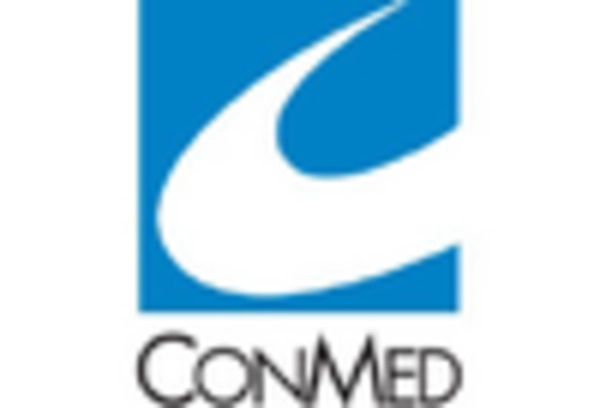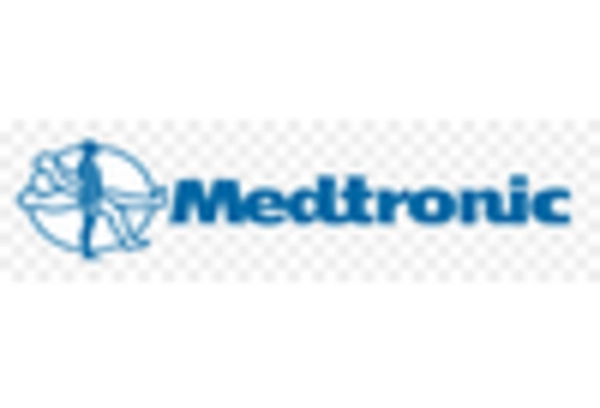Increasing Healthcare Expenditure
The Arthroscopy Fluid Management Disposables Market is benefiting from the increasing healthcare expenditure observed in various regions. Governments and private sectors are investing more in healthcare infrastructure, which includes the procurement of advanced surgical equipment and disposables. This trend is particularly evident in emerging economies, where rising disposable incomes and a growing middle class are leading to higher demand for quality healthcare services. As healthcare facilities expand and upgrade their surgical capabilities, the need for effective fluid management solutions becomes paramount. Market analysts project that this increase in healthcare spending will contribute to a robust growth trajectory for the arthroscopy fluid management disposables market, with an anticipated growth rate of approximately 5% over the next several years.
Focus on Infection Control and Safety
In the Arthroscopy Fluid Management Disposables Market, there is a growing emphasis on infection control and patient safety. The rise in healthcare-associated infections has prompted healthcare facilities to adopt stringent protocols for sterilization and disposables usage. This focus on safety is leading to an increased demand for single-use fluid management products, which are perceived as safer alternatives to reusable devices. Market data indicates that the segment for single-use disposables is expected to grow at a CAGR of 7% over the next few years. Manufacturers are responding by developing products that not only meet safety standards but also enhance the overall efficiency of arthroscopic procedures. This trend underscores the importance of infection control in driving market growth.
Rising Demand for Minimally Invasive Procedures
The Arthroscopy Fluid Management Disposables Market is significantly influenced by the rising demand for minimally invasive surgical procedures. Patients and healthcare providers increasingly prefer these techniques due to their associated benefits, such as reduced recovery times, lower risk of complications, and minimal scarring. As a result, the market for arthroscopy fluid management disposables is expected to expand, with estimates suggesting a growth rate of around 5% annually. This trend is further supported by advancements in surgical instruments and techniques that facilitate minimally invasive approaches. The increasing prevalence of orthopedic disorders and sports injuries also contributes to the heightened demand for arthroscopic surgeries, thereby driving the need for effective fluid management solutions.
Aging Population and Rising Incidence of Joint Disorders
The Arthroscopy Fluid Management Disposables Market is significantly impacted by the aging population and the rising incidence of joint disorders. As the global population ages, the prevalence of conditions such as osteoarthritis and other degenerative joint diseases is increasing. This demographic shift is leading to a higher demand for arthroscopic surgeries, which are often preferred for their minimally invasive nature. Market data suggests that the incidence of joint disorders is expected to rise by 20% over the next decade, further driving the need for effective fluid management solutions during these procedures. Consequently, the arthroscopy fluid management disposables market is poised for growth, as healthcare providers seek to enhance surgical outcomes and patient satisfaction.
Technological Advancements in Arthroscopy Fluid Management
The Arthroscopy Fluid Management Disposables Market is experiencing a notable transformation due to rapid technological advancements. Innovations in fluid management systems, such as automated fluid delivery and real-time monitoring, enhance surgical precision and patient outcomes. The integration of smart technologies, including sensors and data analytics, allows for better control of fluid dynamics during arthroscopic procedures. This trend is supported by a growing body of research indicating that improved fluid management can reduce complications and enhance recovery times. As a result, the market is projected to witness a compound annual growth rate (CAGR) of approximately 6% over the next five years, driven by these advancements. Furthermore, the increasing adoption of robotic-assisted surgeries is likely to further propel the demand for sophisticated fluid management disposables.


















Leave a Comment